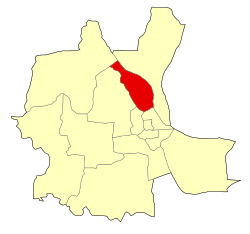Khan Russey Keo
Russey Keo
ឫស្សីកែវ | |
|---|---|
| Russey Keo District Khan Russey Keo ខណ្ឌឫស្សីកែវ | |
 Location of Russey Keo within Phnom Penh | |
| Coordinates:11°37′10″N104°54′36″E/ 11.61946°N 104.9099°E | |
| Country | |
| Province | Phnom Penh |
| Area | |
| • Total | 23.3 km2(9.0 sq mi) |
| Population (2019)[1] | |
| • Total | 274,861 |
| Time zone | UTC+7(ICT) |
| Postal code | 12100 |
| Geocode | 1207 |
Russey Keo(Khmer:ប្ញស្សីកែវ[ʔrɨhsəjkaew];meaning "Crystal Bamboo" ), also spelled asRussei Keo,is a district (khan) inPhnom Penh,Cambodia.This district consists of the northern and north-eastern outskirts of the main city of Phnom Penh, stretching fromKhan Sen Sokin the west to theTonlé Sap Riverin the east. As of 2019, it is the most populous district of Phnom Penh.
History
[edit]Two legends of the Royal Chronicles: the origins of the Emerald Buddha
[edit]There are two occurrences of Russey Keo in theCambodian Royal Chronicles.
The first occurrence is in the story of legendary kingBaksei Chamkrong;Baksey Chamkrong escapes from Angkor and finds refuge on Phnom Baset, southwest ofOudong,before fleeing to the island of Russey Keo where he was surrounded by his opponents.
The second occurrence of Russey Keo mentions this area as the settlement ofBuddhagosa,who landed on Russey Keo after a storm disrupted his travels sailing fromLangkatoLaos.It is during this trip that he was travelling with various treasures, "jewels of sacred fire", such as several sacred texts of thePali canontheOunalom,Buddha'ssynophrysor unibrow, which gave their name to two local pagodasWat OunalomandWat Langka.The Khmer King Batum Soryavong then came to help these settlements, and invited the monk to settle in Angkor with the statue of theEmerald Buddha,[2]thePhra Kaeo Morakot,etiologicallygiving its name to the area.[3]
The foreigner's settlement along the Tonle Sap since the 17th century
[edit]Russey Keo, on the banks of the Tonle Sap River, is where the Dutch merchants established in the 17th century, given its name to one of the neighbourhoods of the district,Hoaland.The Catholic missionaries established their first parish calledSaint Joseph's Catholic Churchthrough a gift of land from KingNorodomin 1867.[4]Russey Keo district, soon became a gathering point for Annamites of all religious persuasions, the home ofPhnom Penh cathedraland many pagodas.[5]
The dredging and developing of a new urban neighbourhood since 1990
[edit]Russey Keo has experienced dramatic urban development since the 1990s, including land reclamation. In March 1991, the People's Committee of Phnom Penh recommended thedredgingof zones in Russey Keo, and in May 1991, theCabinet Council of Ministers of Cambodiaauthorized the pumping of sand to enlarge the city. These developments have also giving rise toforced evictions[6]and a certain number of land disputes, as those between collective groups of people and their Chief of Village who allegedly sold communal land and kept the money.[7]Among these major developments,Camko Cityis an urban development zone being developed by a consortium spearheaded by World City Co., Ltd of South Korea in the Russey Keo district. It has a projected investment valued at $2.063 billion.
Administration
[edit]According to the 1998 census, Russey Keo consisted of 12communes(sangkats) with a total population of 180,076;[8]in 2008–2009 threesangkats—Khmuonh, Phnom Penh Thmei andTuek Thla—formedKhan Sen Sok[9]and the population recorded by the 2008 census in the resulting nine-Sangkat area was 175,295.[10]
In 2008, the number ofKhans(districts) in Phnom Penh increased from 7 to 8, with the division of Russey Keo District into two: Russey Keo and Sen Sok.[11]
In 2010, Bak Kaeng and Koh Dach communes were added to the Khan fromMukh Kampul District,Kandal Province.[12] In 2013, bothsangkats,along with Chroy Changvar, Preaek Lieb and Preaek Ta Sek, formed a new entity,Khan Chroy Changvar,[13]taking Russey Keo's number of Sangkats to six. In 2016, Tuol Sangkae was split in two separate Sangkats, Tuol Sangkae I and Tuol Sangkae II.[13]
As of 2020, Russey Keo is subdivided into seven communes (sangkats) and 30 villages (phums).[13]
| Geocode | Commune | Village |
|---|---|---|
| 120703 | Svay Pak | La Kambaor, Lu,Svay Pak |
| 120704 | Kilomet Prammouy | Kraol Kou, Spean Khpos, Boeung Chhuk |
| 120706 | Russey Keo | Mittapheap, Samakki, Khleang Sang, Boeung Salang |
| 120711 | Chrang Chamreh I | Phum I, Phum II, Phum II, Phum IV |
| 120712 | Chrang Chamreh II | Phum Ka, Phum Kha I, Phum Kha II, Phum Koa |
| 120713 | Tuol Sangkae I | Phsar Touch, Tuol Sangkae, Tuol Kork, Chong Khsach, Bak Touk, Tuol Sampov |
| 120714 | Tuol Sangkae II | Kongkea Phos, Kos Andaet, Pong Peav, Boeung Rang, Tuol Porpae, Tuol Thgan |
See also
[edit]References
[edit]- ^"General Population Census of the Kingdom of Cambodia 2019 – Final Results"(PDF).National Institute of Statistics.Ministry of Planning.26 January 2021.Retrieved3 February2021.
- ^Mak, Phoeun (1984).Chroniques royales du Cambodge: Volume 1 (des origines légendaires jusqu'à Paramaraja)(in French). EFEO. pp. 359–360.ISBN2-85539-537-2.OCLC469801653.
- ^Jacques, Dolias (2012).Le crocodile ou la nâgî: l'océan dans l'imaginaire cambodgien(in French). Les Indes savantes. p. 102.ISBN978-2-84654-318-7.OCLC826978456.
- ^Ninh, Thien-Huong T. (2017-08-15).Race, Gender, and Religion in the Vietnamese Diaspora: The New Chosen People.Springer. p. 108.ISBN978-3-319-57168-3.
- ^Edwards, Penny (2007-01-01).Cambodge: The Cultivation of a Nation, 1860-1945.University of Hawaii Press. p. 56.ISBN978-0-8248-2923-0.
- ^Fernandes, Kenneth (1998).Forced Evictions and Housing Right Abuses in Asia: Second Report 1996-1997.City Press. p. 30.ISBN978-969-8380-08-3.
- ^Chari, Sharad; Freidberg, Susanne; Gidwani, Vinay; Ribot, Jesse; Wolford, Wendy (2017-10-02).Other Geographies: The Influences of Michael Watts.John Wiley & Sons. p. 207.ISBN978-1-119-18477-5.
- ^"General Population Census of Cambodia 1998, Final Census Results"(PDF).National Institute of Statistics, Ministry of Planning, Cambodia. August 2002. p. 174.Retrieved23 May2020.
- ^"General Population Census of Cambodia 2008"(PDF).National Institute of Statistics. August 2009. p. 170.Retrieved23 May2020.
- ^"2008 Census – Ruessei Kaev District".opendevelopmentcambodia.net.Open Development Cambodia.Retrieved23 May2020.
- ^Biswas, Asit K.; Sachdeva, Pawan K.; Tortajada, Cecilia (2020-12-10).Phnom Penh Water Story: Remarkable Transformation of an Urban Water Utility.Springer Nature. p. 14.ISBN978-981-334-065-7.
- ^"Administrative Area Changes of Phnom Penh Municipality on 5 November 2010"(PDF).stat.go.jp.Statistics Bureau of Japan.Retrieved23 May2020.
- ^abc"Cambodia Gazetteer Database Online".National Committee for Sub-National Democratic Development.Retrieved23 May2020.

